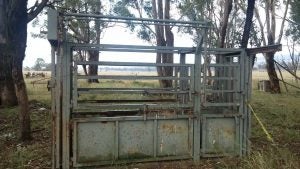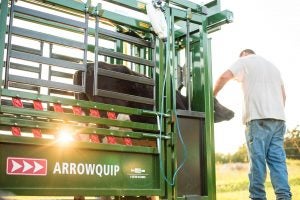Evolution and technology has allowed us to move beyond our primitive beginnings as cave dwellers and enjoy our current lifestyle, smartphone in hand. No facet of our life is immune to evolution, and we have also seen dramatic evolution in cattle chutes and handling.
The romanticized image of cattle handling shows a weather worn cowboy working a group of cattle on his horse in the wide-open plains. That all began to change when barbed wire was invented in the 1870s, allowing ranchers to fence in areas to contain cattle. Fences also reduced cattle raiding, which is thought to be one of the earliest forms of theft.
Although the history isn’t well documented, we expect that clever stockmen began using makeshift cattle chutes soon after they began building more fences. Cattle chutes minimize animal stress and prevent injuries to handlers and animals. There are many reasons that we need to handle cattle, including routine veterinary care, branding or ear tagging, and castration. Chutes replaced more challenging practices of cutting, roping, and heeling cattle.
Early chutes were simple and homemade, consisting of using a corner of the corral and the existing fence, while swinging a gate around to confine the animal for a procedure. Cattle still needed to be cut out of the herd, making this a tedious but safer practice for the handlers, but a stressful situation for the animals.

In the 1970s, a more conscientious effort at animal husbandry began taking shape. As an industry, we realized that business as usual couldn’t continue. A spike in animal handling research transformed stockmanship skills from optional to essential. Those who work with cattle focus on cow comfort and animal science practices in their techniques.
Cattle chute design and stockmanship techniques evolved as we learned more about the basic principles of cattle behavior. The principles are based on three main tenets of good stockmanship: animal welfare, quality of life, and performance. Dr. Ron Gill of Texas A&M University outlines five of these on his Effective Stockmanship website:
- Cattle want to be able to see handlers.
- Cattle want to go around handlers.
- Cattle want to be with other cattle; they are herd animals.
- Cattle want to remove pressure from a handler or equipment.
- Cattle only have one main thought at a time.
Extensive research at universities throughout the world has helped evolve cattle chutes into the innovative equipment we utilize today. Dr. Temple Grandin of Colorado State University is a leader in this field, and has developed some of the technology universally adopted in cattle chutes. Her research into the flight zone, vision, noise, and herd behavior of cattle helped develop less stressful handling situations and practices.
The cattle chute is the most important piece of equipment in a cattle-handling facility. This is where a procedure will take place, and the greatest risk of stress and injury occurs. Cattle chutes all share the same basic design, some sort of gate or head gate at the front, two sturdy sides that allow handlers to access cattle for care, and a gate at the back so that cattle cannot back out of the chute.
From the basic chute design, innovation took over, using the research from engineers and animal scientists, and practical knowledge from the field to create complex machines that handle cattle safely. Handles on the head gate were made more user friendly, while the gate itself has become safer for the cattle. Flooring in chutes is non-slip to ensure animal safety. Vet door access points in chutes are in more locations. Chutes are built out of materials that won’t bruise or injure the animal, and can be adjusted for different sized animals.

Today’s chutes are quiet, reducing animal stress by eliminating the grating noise of hinges swinging closed and slamming gates. Head gates are far easier to operate for handlers, and many chutes gently squeeze cattle to reduce stress and increase safety. Sides of chutes can be open or closed for animal vision, and the head gate release is seamless, allowing the animal to quickly and safely exit the chute when the procedure is complete.
Further research by Grandin in the early 2000s showed that new things and novelty items attract cattle, and that they can be trained to accept voluntary constraint. Introducing cattle to equipment prior to using the equipment for any procedures can reduce stress and make cattle handling practices more efficient. She found and published in 2014 that animal learning is specific and cattle need to be acclimated to the specific cattle chute they will receive procedures in for the training to be effective. Many stockmen include cattle acclimatization into their routines at their operation.
At the same time that cattle chutes and animal handling techniques were changing, our understanding of genetics was evolving. We have learned more about how genetics work and selecting traits in cattle. Cattle have approximately 22,000 genes, and some of these make a difference in cattle handling, including: temperament (how they respond to isolation during handling), fear, habituation for handling, and aggressiveness. Geneticists and cattle breeders carefully select for traits that improve the behavioral characteristics of cattle while also improving production traits, and have been selecting for a calmer temperament since the late 1990s.
The cattle chute, partnered with alleys and tubs, has become an indispensable part of the team on every cattle operation. While some people may long for aspects of the “good old days,” we can all agree that the evolution of cattle chutes into the equipment we enjoy today is a safety and efficiency factor that we will not give up.
Sources:
http://effectivestockmanship.com/
https://www.grandin.com/references/new.corral.html
https://en.wikipedia.org/wiki/Cattle
https://web.archive.org/web/20071223111210/
http://agriculture.kzntl.gov.za/portal/Publications/ProductionGuidelines/BeefProduction/CattleHandlingFacilities/tabid/117/Default.aspx


